2016 Hyundai Elantra belt
[x] Cancel search: beltPage 47 of 498

329
Safety features of your vehicle
Infant or small child
You should be aware of the specific
requirements in your country. Child
and/or infant seats must be properly
placed and installed in the rear seat.
For more information about the use
of these restraints, refer to “Child
restraint system” in this section.
✽NOTICE
Small children are best protected
from injury in an accident when
properly restrained in the rear seat
by a child restraint system that
meets the requirements of the Safety
Standards of your country. Before
buying any child restraint system,
make sure that it has a label certify-
ing that it meets Safety Standards of
your country. The restraint must be
appropriate for your child's height
and weight. Check the label on the
child restraint for this information.
Refer to “Child restraint system” in
this section.
Larger children
Children who are too large for child
restraint systems should always
occupy the rear seat and use the
available lap/shoulder belts. The lap
portion should be fastened and snug
on the hips and as low as possible.
Check if the seat belt fits periodically.
A child's squirming could put the seat
belt out of position. Children are
given the most safety in the event of
an accident when they are restrained
by a proper restraint system in the
rear seat. If a larger child (over age
12) must be seated in the front seat,
the child should be securely
restrained by the available lap/shoul-
der belt and the seat should be
placed in the rearmost position.
Children age 12 and under should be
restrained securely in the rear seat.
NEVER place a child age 12 and
under in the front seat. NEVER place
a rear facing child seat in the front
seat of a vehicle.
WARNING
Every person in your vehicle
needs to be properly restrained
at all times, including infants
and children. Never hold a child
in your arms or lap when travel-
ling in a vehicle. The violent
forces created during a crash
will tear the child from your
arms and throw the child
against the interior. Always use
a child restraint appropriate for
your child's height and weight.
Page 48 of 498
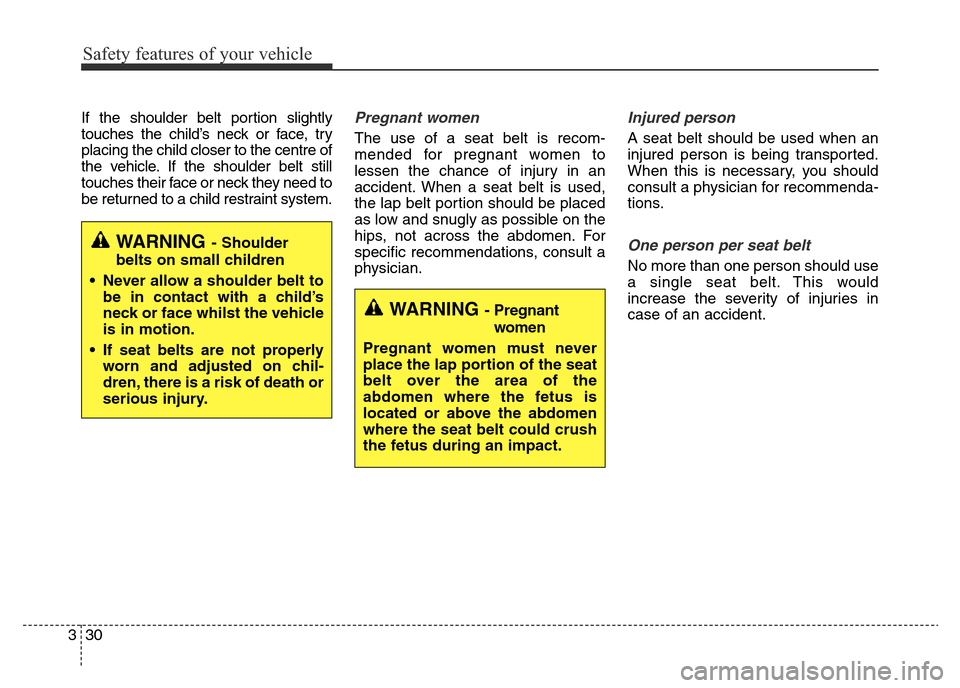
Safety features of your vehicle
30 3
If the shoulder belt portion slightly
touches the child’s neck or face, try
placing the child closer to the centre of
the vehicle. If the shoulder belt still
touches their face or neck they need to
be returned to a child restraint system.Pregnant women
The use of a seat belt is recom-
mended for pregnant women to
lessen the chance of injury in an
accident. When a seat belt is used,
the lap belt portion should be placed
as low and snugly as possible on the
hips, not across the abdomen. For
specific recommendations, consult a
physician.
Injured person
A seat belt should be used when an
injured person is being transported.
When this is necessary, you should
consult a physician for recommenda-
tions.
One person per seat belt
No more than one person should use
a single seat belt. This would
increase the severity of injuries in
case of an accident.
WARNING- Shoulder
belts on small children
• Never allow a shoulder belt to
be in contact with a child’s
neck or face whilst the vehicle
is in motion.
• If seat belts are not properly
worn and adjusted on chil-
dren, there is a risk of death or
serious injury.
WARNING - Pregnant
women
Pregnant women must never
place the lap portion of the seat
belt over the area of the
abdomen where the fetus is
located or above the abdomen
where the seat belt could crush
the fetus during an impact.
Page 49 of 498
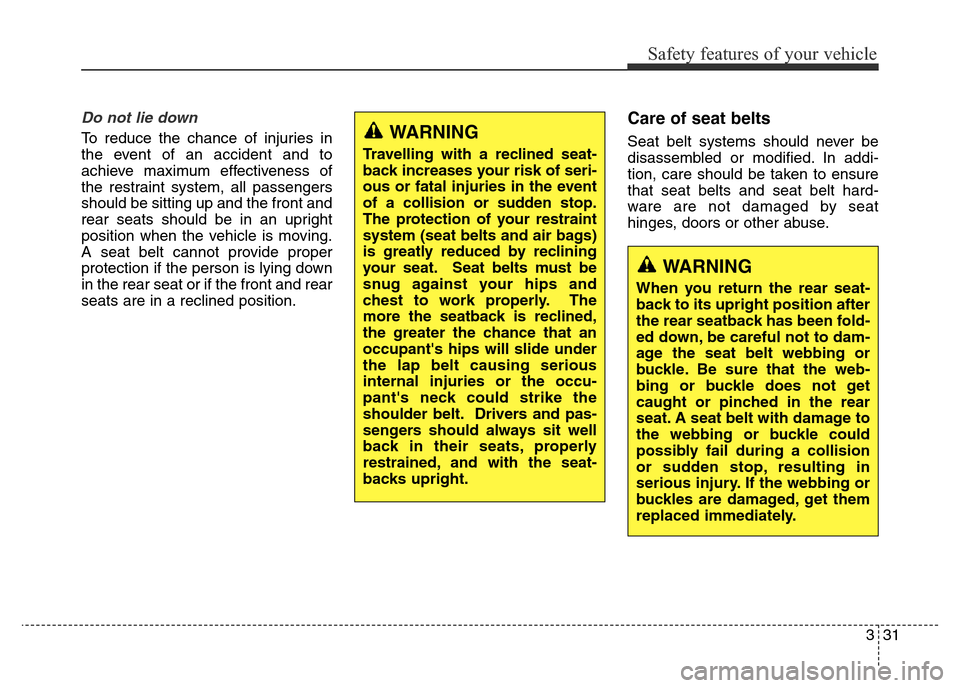
331
Safety features of your vehicle
Do not lie down
To reduce the chance of injuries in
the event of an accident and to
achieve maximum effectiveness of
the restraint system, all passengers
should be sitting up and the front and
rear seats should be in an upright
position when the vehicle is moving.
A seat belt cannot provide proper
protection if the person is lying down
in the rear seat or if the front and rear
seats are in a reclined position.
Care of seat belts
Seat belt systems should never be
disassembled or modified. In addi-
tion, care should be taken to ensure
that seat belts and seat belt hard-
ware are not damaged by seat
hinges, doors or other abuse.WARNING
Travelling with a reclined seat-
back increases your risk of seri-
ous or fatal injuries in the event
of a collision or sudden stop.
The protection of your restraint
system (seat belts and air bags)
is greatly reduced by reclining
your seat. Seat belts must be
snug against your hips and
chest to work properly. The
more the seatback is reclined,
the greater the chance that an
occupant's hips will slide under
the lap belt causing serious
internal injuries or the occu-
pant's neck could strike the
shoulder belt. Drivers and pas-
sengers should always sit well
back in their seats, properly
restrained, and with the seat-
backs upright.
WARNING
When you return the rear seat-
back to its upright position after
the rear seatback has been fold-
ed down, be careful not to dam-
age the seat belt webbing or
buckle. Be sure that the web-
bing or buckle does not get
caught or pinched in the rear
seat. A seat belt with damage to
the webbing or buckle could
possibly fail during a collision
or sudden stop, resulting in
serious injury. If the webbing or
buckles are damaged, get them
replaced immediately.
Page 50 of 498
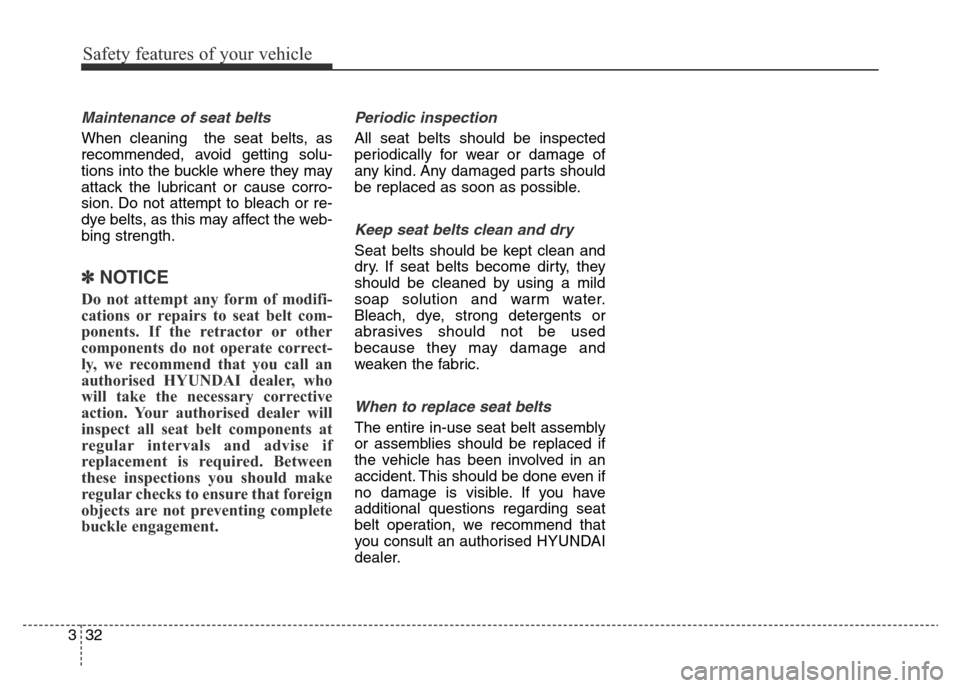
Safety features of your vehicle
32 3
Maintenance of seat belts
When cleaning the seat belts, as
recommended, avoid getting solu-
tions into the buckle where they may
attack the lubricant or cause corro-
sion. Do not attempt to bleach or re-
dye belts, as this may affect the web-
bing strength.
✽NOTICE
Do not attempt any form of modifi-
cations or repairs to seat belt com-
ponents. If the retractor or other
components do not operate correct-
ly, we recommend that you call an
authorised HYUNDAI dealer, who
will take the necessary corrective
action. Your authorised dealer will
inspect all seat belt components at
regular intervals and advise if
replacement is required. Between
these inspections you should make
regular checks to ensure that foreign
objects are not preventing complete
buckle engagement.
Periodic inspection
All seat belts should be inspected
periodically for wear or damage of
any kind. Any damaged parts should
be replaced as soon as possible.
Keep seat belts clean and dry
Seat belts should be kept clean and
dry. If seat belts become dirty, they
should be cleaned by using a mild
soap solution and warm water.
Bleach, dye, strong detergents or
abrasives should not be used
because they may damage and
weaken the fabric.
When to replace seat belts
The entire in-use seat belt assembly
or assemblies should be replaced if
the vehicle has been involved in an
accident. This should be done even if
no damage is visible. If you have
additional questions regarding seat
belt operation, we recommend that
you consult an authorised HYUNDAI
dealer.
Page 51 of 498
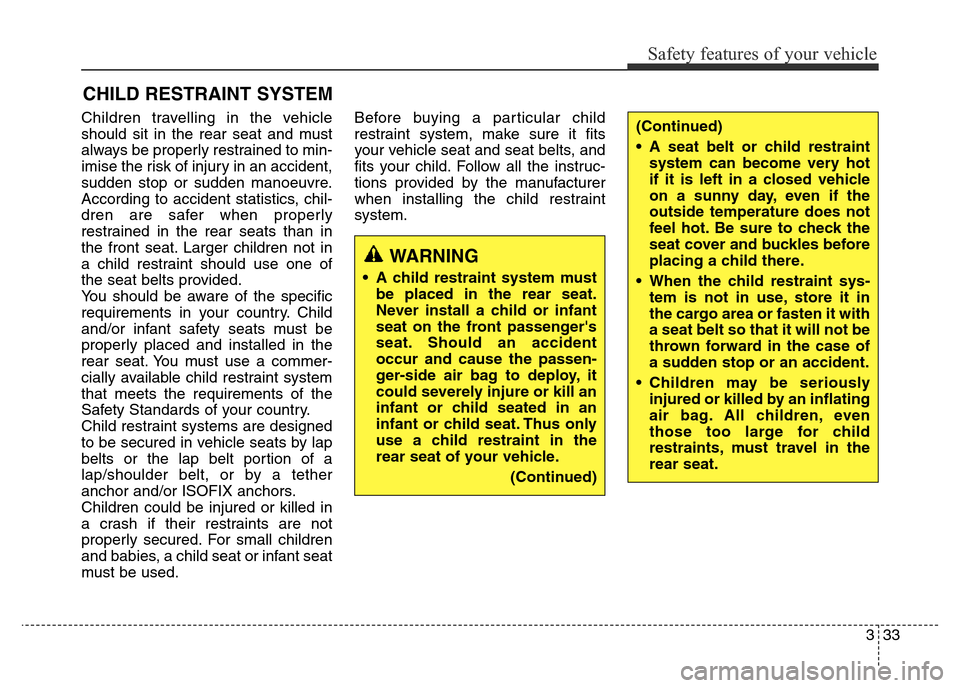
333
Safety features of your vehicle
Children travelling in the vehicle
should sit in the rear seat and must
always be properly restrained to min-
imise the risk of injury in an accident,
sudden stop or sudden manoeuvre.
According to accident statistics, chil-
dren are safer when properly
restrained in the rear seats than in
the front seat. Larger children not in
a child restraint should use one of
the seat belts provided.
You should be aware of the specific
requirements in your country. Child
and/or infant safety seats must be
properly placed and installed in the
rear seat. You must use a commer-
cially available child restraint system
that meets the requirements of the
Safety Standards of your country.
Child restraint systems are designed
to be secured in vehicle seats by lap
belts or the lap belt portion of a
lap/shoulder belt, or by a tether
anchor and/or ISOFIX anchors.
Children could be injured or killed in
a crash if their restraints are not
properly secured. For small children
and babies, a child seat or infant seat
must be used.Before buying a particular child
restraint system, make sure it fits
your vehicle seat and seat belts, and
fits your child. Follow all the instruc-
tions provided by the manufacturer
when installing the child restraint
system.
CHILD RESTRAINT SYSTEM
WARNING
• A child restraint system must
be placed in the rear seat.
Never install a child or infant
seat on the front passenger's
seat. Should an accident
occur and cause the passen-
ger-side air bag to deploy, it
could severely injure or kill an
infant or child seated in an
infant or child seat. Thus only
use a child restraint in the
rear seat of your vehicle.
(Continued)
(Continued)
• A seat belt or child restraint
system can become very hot
if it is left in a closed vehicle
on a sunny day, even if the
outside temperature does not
feel hot. Be sure to check the
seat cover and buckles before
placing a child there.
• When the child restraint sys-
tem is not in use, store it in
the cargo area or fasten it with
a seat belt so that it will not be
thrown forward in the case of
a sudden stop or an accident.
• Children may be seriously
injured or killed by an inflating
air bag. All children, even
those too large for child
restraints, must travel in the
rear seat.
Page 52 of 498

Safety features of your vehicle
34 3
(Continued)
• Never put a seat belt over your-
self and a child. During a crash,
the seat belt could press deep
into the child causing serious
internal injuries.
• Never leave children unattend-
ed in a vehicle – not even for a
short time. The vehicle can
heat up very quickly, resulting
in serious injuries to children
inside. Even very young chil-
dren may inadvertently cause
the vehicle to move, entangle
themselves in the windows, or
lock themselves or others
inside the vehicle.
• Never allow two children, or
any two adults, to use the same
seat belt.
• Children often squirm and
reposition themselves improp-
erly. Never let a child travel
with the shoulder belt under
their arm or behind their back.
Always properly position and
secure children in rear seat.
(Continued)(Continued)
• Never allow a child to stand-up
or kneel on the seat or floor-
board of a moving vehicle.
During a collision or sudden
stop, the child can be violently
thrown against the vehicle's
interior, resulting in serious
injury.
• Never use an infant carrier or a
child safety seat that "hooks"
over a seatback, it may not pro-
vide adequate security in an
accident.
• Seat belts can become very
hot, especially when the vehi-
cle is parked in direct sunlight.
Always check seat belt buckles
before fastening them over a
child.
• After an accident, we recom-
mend that the system be
checked by an authorised
HYUNDAI dealer.
• If there is not enough space
behind the driver's seat to
place the child restraint sys-
tem, install the child restraint
system in the rear seat, behind
the front passenger's seat.WARNING
To reduce the chance of serious
or fatal injuries:
• Children of all ages are safer
when restrained in the rear
seat. A child travelling in the
front passenger seat can be
forcefully struck by an inflating
air bag resulting in serious or
fatal injuries.
• Always follow the instructions
for installation and use of the
child restraint manufacturer.
• Always make sure the child
seat is secured properly in the
vehicle and your child is
securely restrained in the child
seat.
• Never hold a child in your arms
or lap when travelling in a vehi-
cle. The violent forces created
during a crash will tear the
child from your arms and throw
the child against the vehicle’s
interior.
(Continued)
Page 53 of 498
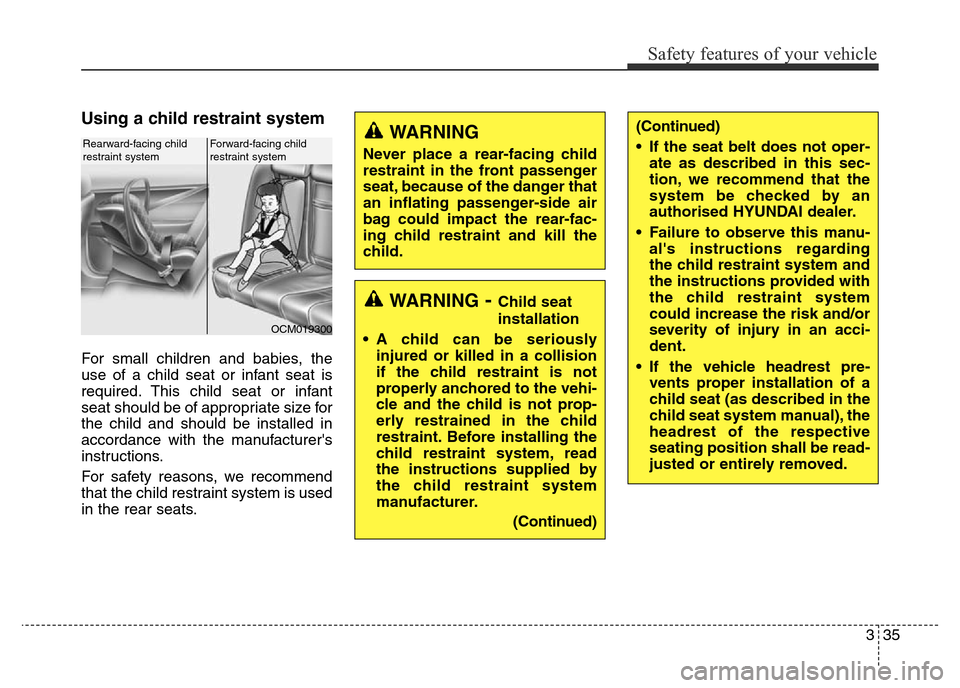
335
Safety features of your vehicle
Using a child restraint system
For small children and babies, the
use of a child seat or infant seat is
required. This child seat or infant
seat should be of appropriate size for
the child and should be installed in
accordance with the manufacturer's
instructions.
For safety reasons, we recommend
that the child restraint system is used
in the rear seats.
WARNING- Child seat
installation
• A child can be seriously
injured or killed in a collision
if the child restraint is not
properly anchored to the vehi-
cle and the child is not prop-
erly restrained in the child
restraint. Before installing the
child restraint system, read
the instructions supplied by
the child restraint system
manufacturer.
(Continued)
WARNING
Never place a rear-facing child
restraint in the front passenger
seat, because of the danger that
an inflating passenger-side air
bag could impact the rear-fac-
ing child restraint and kill the
child.
OCM019300
Rearward-facing child
restraint systemForward-facing child
restraint system
(Continued)
• If the seat belt does not oper-
ate as described in this sec-
tion, we recommend that the
system be checked by an
authorised HYUNDAI dealer.
• Failure to observe this manu-
al's instructions regarding
the child restraint system and
the instructions provided with
the child restraint system
could increase the risk and/or
severity of injury in an acci-
dent.
• If the vehicle headrest pre-
vents proper installation of a
child seat (as described in the
child seat system manual), the
headrest of the respective
seating position shall be read-
justed or entirely removed.
Page 54 of 498
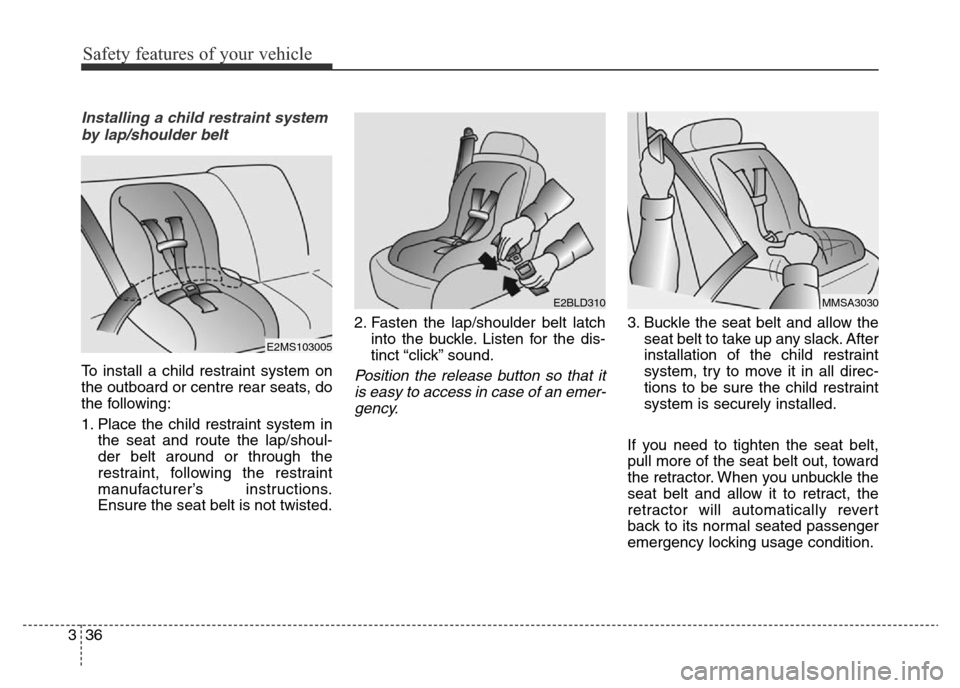
Safety features of your vehicle
36 3
Installing a child restraint system
by lap/shoulder belt
To install a child restraint system on
the outboard or centre rear seats, do
the following:
1. Place the child restraint system in
the seat and route the lap/shoul-
der belt around or through the
restraint, following the restraint
manufacturer’s instructions.
Ensure the seat belt is not twisted.2. Fasten the lap/shoulder belt latch
into the buckle. Listen for the dis-
tinct “click” sound.Position the release button so that it
is easy to access in case of an emer-
gency.
3. Buckle the seat belt and allow the
seat belt to take up any slack. After
installation of the child restraint
system, try to move it in all direc-
tions to be sure the child restraint
system is securely installed.
If you need to tighten the seat belt,
pull more of the seat belt out, toward
the retractor. When you unbuckle the
seat belt and allow it to retract, the
retractor will automatically revert
back to its normal seated passenger
emergency locking usage condition.
MMSA3030E2BLD310
E2MS103005